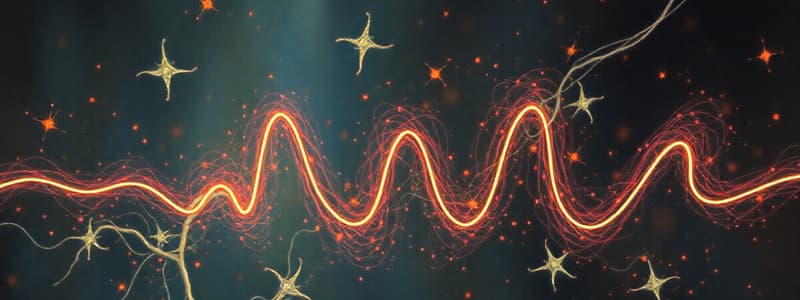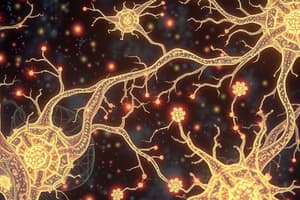Podcast
Questions and Answers
Which is true of a neuron with a resting potential?
Which is true of a neuron with a resting potential?
- The sodium pump has moved Na+ to the outside of the plasma membrane. (correct)
- The outer surface of the plasma membrane has a negative charge.
- The cell membrane is permeable to Na+ but impermeable to K+ ions.
- The highest concentration of K+ is extracellular.
The first event to occur when an adequate stimulus is applied to a neuron is:
The first event to occur when an adequate stimulus is applied to a neuron is:
- the sodium channels are inactivated.
- some of the sodium channels at the point of stimulation open. (correct)
- the potassium channels open.
- the membrane potential moves immediately to a value of +30 mV.
Which is true of an action potential?
Which is true of an action potential?
- Na+ ions move extracellularly.
- The outside of the plasma membrane is negatively charged, and the inside is positively charged. (correct)
- The charges become equal on the outside and inside of the plasma membrane.
- The plasma membrane is impermeable to Na+ and K+ ions.
The only ion(s) that can diffuse across a neuron's membrane when the neuron is at rest is (are):
The only ion(s) that can diffuse across a neuron's membrane when the neuron is at rest is (are):
A slight shift away from the resting membrane potentials in a specific region of the plasma membrane is called a _____ potential.
A slight shift away from the resting membrane potentials in a specific region of the plasma membrane is called a _____ potential.
During a relative refractory period:
During a relative refractory period:
Within the nervous system, coding for the strength of a stimulus is accomplished through:
Within the nervous system, coding for the strength of a stimulus is accomplished through:
The fastest nerve fibers in the body can conduct impulses up to approximately _____ meters per second.
The fastest nerve fibers in the body can conduct impulses up to approximately _____ meters per second.
A synapse consists of:
A synapse consists of:
A synaptic knob would be located on a(n):
A synaptic knob would be located on a(n):
When an impulse reaches a synapse:
When an impulse reaches a synapse:
Excitatory neurotransmitters are most likely to:
Excitatory neurotransmitters are most likely to:
When current leaps across an insulating myelin sheath from node to node, the type of impulse conduction is called:
When current leaps across an insulating myelin sheath from node to node, the type of impulse conduction is called:
For a neurotransmitter to produce an inhibitory postsynaptic potential, which of the following channels must open?
For a neurotransmitter to produce an inhibitory postsynaptic potential, which of the following channels must open?
Which of the following is true of spatial summation?
Which of the following is true of spatial summation?
Which of the following is not one of the main chemical classes of neurotransmitters?
Which of the following is not one of the main chemical classes of neurotransmitters?
Serotonin is an example of a(n):
Serotonin is an example of a(n):
The neurotransmitter(s) that inhibit(s) the conduction of pain impulses is(are):
The neurotransmitter(s) that inhibit(s) the conduction of pain impulses is(are):
Neurotransmitters are released in a synapse and bind to:
Neurotransmitters are released in a synapse and bind to:
Which of the following statements about amino acid neurotransmitters is incorrect?
Which of the following statements about amino acid neurotransmitters is incorrect?
Severe depression can be caused by a deficit in certain brain synapses of:
Severe depression can be caused by a deficit in certain brain synapses of:
Which of the following is not used by the body as a neurotransmitter?
Which of the following is not used by the body as a neurotransmitter?
Which of the following antidepressants acts by blocking the action of monoamine oxidase (MAO)?
Which of the following antidepressants acts by blocking the action of monoamine oxidase (MAO)?
Compared with the outside of the neuron, the inside has a(n) _____ charge.
Compared with the outside of the neuron, the inside has a(n) _____ charge.
Acetylcholine is in the same class of neurotransmitters as:
Acetylcholine is in the same class of neurotransmitters as:
Dopamine, epinephrine, and norepinephrine are classified as:
Dopamine, epinephrine, and norepinephrine are classified as:
Stimulus-gated channels open in response to:
Stimulus-gated channels open in response to:
The fastest nerve fibers in the body can conduct an impulse that is how much faster than the slowest fibers in the body?
The fastest nerve fibers in the body can conduct an impulse that is how much faster than the slowest fibers in the body?
Which neuron could transmit a nerve impulse the fastest?
Which neuron could transmit a nerve impulse the fastest?
No impulse can be sent through a neuron:
No impulse can be sent through a neuron:
A synapse can occur only between an axon and:
A synapse can occur only between an axon and:
The difference between sodium and potassium in the generation of action potential is that:
The difference between sodium and potassium in the generation of action potential is that:
A neurologist is using a voltmeter to measure potential. The membrane potential of a neuron was recorded at +30 mV. This is what type of membrane potential?
A neurologist is using a voltmeter to measure potential. The membrane potential of a neuron was recorded at +30 mV. This is what type of membrane potential?
Which membrane receptor acts to directly change ion permeability when stimulated?
Which membrane receptor acts to directly change ion permeability when stimulated?
Flashcards
Resting Potential
Resting Potential
Neuron at rest; outer plasma membrane is positively charged; sodium pump moved Na+ to the outside.
First Event of Stimulation
First Event of Stimulation
Sodium channels open at the point of stimulation.
Local Potential
Local Potential
Shifting away from resting membrane potentials
Relative Refractory Period
Relative Refractory Period
Signup and view all the flashcards
Stimulus Strength Coding
Stimulus Strength Coding
Signup and view all the flashcards
Synapse
Synapse
Signup and view all the flashcards
Impulse at Synapse
Impulse at Synapse
Signup and view all the flashcards
Excitatory Neurotransmitters
Excitatory Neurotransmitters
Signup and view all the flashcards
Saltatory Conduction
Saltatory Conduction
Signup and view all the flashcards
Potassium/Chloride Channels
Potassium/Chloride Channels
Signup and view all the flashcards
Spatial Summation
Spatial Summation
Signup and view all the flashcards
Serotonin
Serotonin
Signup and view all the flashcards
Neurotransmitters
Neurotransmitters
Signup and view all the flashcards
Neuron's Charge
Neuron's Charge
Signup and view all the flashcards
Acetylcholine
Acetylcholine
Signup and view all the flashcards
Dopamine, Epinephrine, Norepinephrine
Dopamine, Epinephrine, Norepinephrine
Signup and view all the flashcards
Stimulus-Gated Channels
Stimulus-Gated Channels
Signup and view all the flashcards
Large-Diameter Neuron
Large-Diameter Neuron
Signup and view all the flashcards
No Impulse
No Impulse
Signup and view all the flashcards
Sodium/Potassium
Sodium/Potassium
Signup and view all the flashcards
Study Notes
Neuron Resting Potential
- The cell membrane is permeable to sodium but impermeable to potassium ions
- The sodium pump moves sodium to the outside of the plasma membrane
- The outer surface of the plasma membrane has a negative charge
Action Potential
- The first event after an adequate stimulus is to open some sodium channels at the point of stimulation
- During an action potential the charges become equal on both sides of the plasma membrane
- The plasma membrane's outside is negatively charged, and the inside is positively charged during an action potential
Ion Diffusion
- Potassium is the only ion that can diffuse across a neuron's membrane when the neuron is at rest.
Local Potentials
- A slight shift away from the resting membrane potentials in a specific region of the plasma membrane
Refractory Period
- Action potential can be initiated with a strong stimulus during the relative refractory period
- Coding for the strength of a stimulus is accomplished through the frequency of nerve impulses
Nerve Fibers
- The fastest nerve fibers in the body can conduct impulses up to approximately 130 meters per second
Synapses
- A synapse consists of a synaptic knob, a synaptic cleft, and the plasma membrane of a postsynaptic neuron
- A synaptic knob would be located on an axon
- Chemical transmitters are released when an impulse reaches a synapse
- A synapse can occur only between an axon and a dendrite, cell body, or another axon
Synaptic Transmission
- Excitatory neurotransmitters are most likely to initiate an action potential
- Saltatory conduction is when current leaps across an insulating myelin sheath from node to node
- Potassium and/or chloride channels must open for a neurotransmitter to produce an inhibitory postsynaptic potential
- Neurotransmitters are released in a synapse and bind to receptors on the postsynaptic neuron
Summation
- Spatial summation occurs when neurotransmitters released simultaneously from several presynaptic knobs converge on one postsynaptic neuron
Neurotransmitters
- Triglycerides are not one of the main chemical classes of neurotransmitters
- Serotonin is an example of an amine neurotransmitter
- Enkephalins inhibit the conduction of pain impulses
- An incorrect statement about amino acid neurotransmitters is that they are all inhibitory neurotransmitters
- Glycine is a widely distributed inhibitory neurotransmitter in the spinal cord
- Severe depression can be caused by a deficit in certain brain synapses of neuropeptides
- Peroxide is not used by the body as a neurotransmitter
- Phenelzine is an antidepressant that acts by blocking the action of monoamine oxidase (MAO)
- Dopamine, epinephrine, and norepinephrine are classified as catecholamines
Membrane Potential and Impulses
- The inside of a neuron has a negative charge compared with the outside
- Stimulus-gated channels open in response to sensory stimuli
- Fastest nerve fibers in the body can conduct an impulse almost 300 times faster than the slowest fibers
- The fastest nerve impulse transmission occurs in a large-diameter neuron with myelin
- No impulse can be sent through a neuron during the absolute refractory period
Action Potentials
- Sodium causes depolarization of the cell membrane, and potassium causes repolarization of the cell membrane
- A membrane potential of +30 mV indicates an action potential
Membrane Receptors
- A gated-channel receptor acts to directly change ion permeability when stimulated
Studying That Suits You
Use AI to generate personalized quizzes and flashcards to suit your learning preferences.




